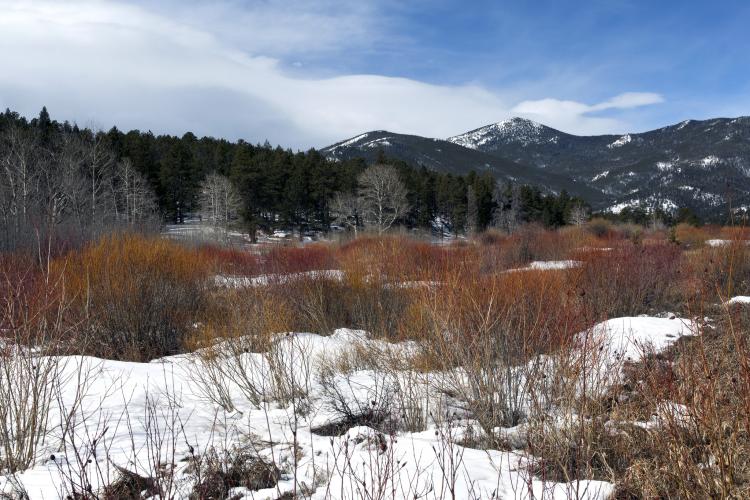In spring, we see colorful willows growing pine cones
Three weekends ago I went to Rocky Mountain National Park to enjoy winter.
I was treated to a colorful sunrise and later I noticed a marshy meadow bright with green, yellow, orange and red willows. Colors were born by stems, not leaves, so the effect was delicate and diaphanous against wind piled banks of snow.
Willows, in the genus Salix, are closely related to cottonwoods and aspens, and all of these are dioecious, meaning that a tree or shrub is either male or female.
Catkins, several-inch-long flowering spikes, bear many fluffy flowers that are white, green, grey or black, depending on the species.
The galls can be seen in the foreground of the accompanying photo — they stand out nicely against the drifts of snow. Some shrubs had dozens of galls, while most had none, suggesting some degree of variation in plant defenses or nutritive value."
Stem colors vary among willow species, but that is as far as I can go, for identification of willow species is difficult, and requires the use of young leaves, mature leaves, stipules (structures at the base of leaf stalks), buds and catkins.
So identification requires repeated visits to a willow at several different times of the year. Furthermore, Professor William Weber lists more than two dozen species on the eastern slope in Colorado, so identification is out of the reach of people with short attention spans.
Horticulturists raise willows so they can add their slender, colorful stems to bouquets. A horticulture paper listing stem colors of 20 species included all shades of brown, black, red with yellow tips, deep red and dark purple red.

Spring brings on bright colors in willow stems that are also bearing galls that look like pine cones. To see larger image, click here. Photo by Jeff Mitton.
Experimental studies have reported that stems with anthocyanins had lower photosynthetic rates than green stems, but also suffered few bouts of photo inhibition under direct sunlight. My guess is that these colors appear in spring, when days are getting longer and brighter but photosynthetic stem tissues are not yet shaded by leaves.
After taking several photos of the willows in Rocky Mountain National Park, I finally noticed that perhaps 20 percent of them had galls that resembled pine cones.
The galls can be seen in the foreground of the accompanying photo — they stand out nicely against the drifts of snow. Some shrubs had dozens of galls, while most had none, suggesting some degree of variation in plant defenses or nutritive value.
The willow pinecone gall midge, Rabdophaga strobiloides, was feeding inside these galls. Midges are small flies with two wings and they are common in marshy environments.
Adult females lay their eggs on the tips of willow in April, and developing larvae burrow into the twig, stimulating galls to form. Larvae feed in and spend the winter in the galls, emerging as adults in the following spring.
One of the willows used by the gall midge is sandbar or coyote willow, Salix exigua, which grows in clones and has a natural range reaching from the banks of the Rio Grande River in southern Texas to the northern slope of Alaska, and throughout Colorado and most western states. Stem colors can be brown, red or yellow.
In central Washington State, a single sandbar willow may have up to 1,000 galls, though the frequency of galls varies both among willows in a population and among population.
Sandbar willow can also be laden with aphids, which are typically protected by ants that harvest excess sugars passed by aphids.
Amy Savage and Merrill Peterson, both based at Western Washington University, examined relative abundances of ants, aphids and midges, which can all occupy the same willow. They found that aphid populations grew faster when they were tended by ants and in the company of midges. Galls were more common on plants that also had ants and aphids. Finally, numbers of ants, aphids and midges were all positively correlated.
When ants are tending aphids on a willow, they attack most insects and their aggressive behavior may reduce parasitism of midge galls. In addition, midges and aphids both drain resources from the plant, perhaps reducing its ability to produce an adequate level of defensive compounds.
While neither of these relationships has been confirmed experimentally, they are both plausible and may explain why ants, aphids and midges all thrive in the presence of the others.

